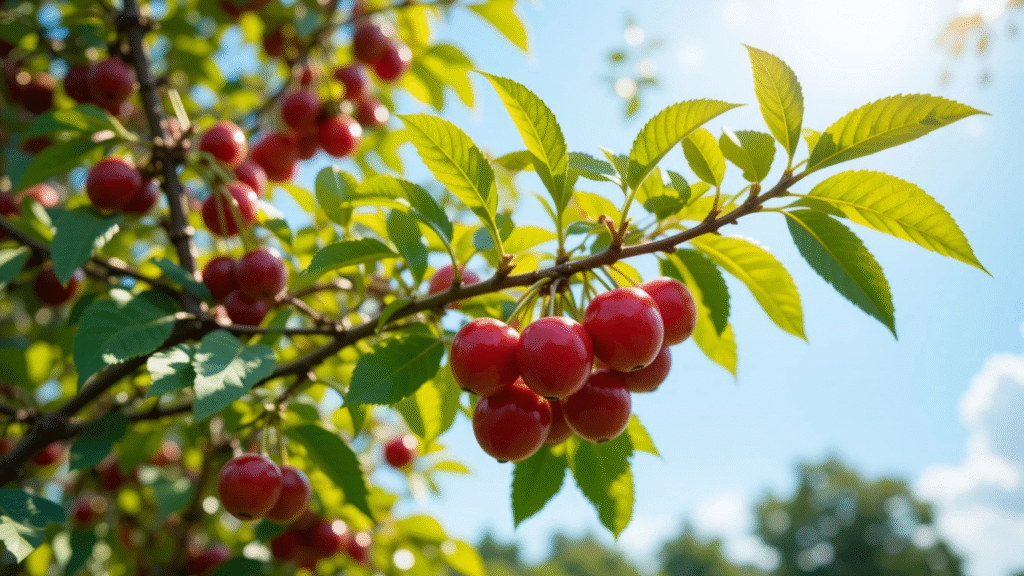
How to Prevent Cherry Tree Diseases: Essential Care Tips
Growing cherry trees can be a rewarding experience, but nothing is more frustrating than watching your beautiful tree succumb to diseases. 🌳🍒 If you’re wondering how to prevent cherry tree diseases: essential care tips to keep your tree thriving, you’ve come to the right place! From vibrant blossoms to juicy fruit, your cherry tree deserves the best care to stay healthy and strong. In this guide, we’ll explore practical tips and tricks that will help you protect your tree from common diseases and ensure it flourishes year after year. Let’s get started on your cherry tree’s journey to health!
Table of Contents
ToggleUnderstanding Cherry Tree Diseases 🍒🌱
Cherry trees, like all plants, are susceptible to various diseases that can affect their growth, fruit production, and overall health. Understanding these diseases is the first step in prevention. Here are some of the most common ones:
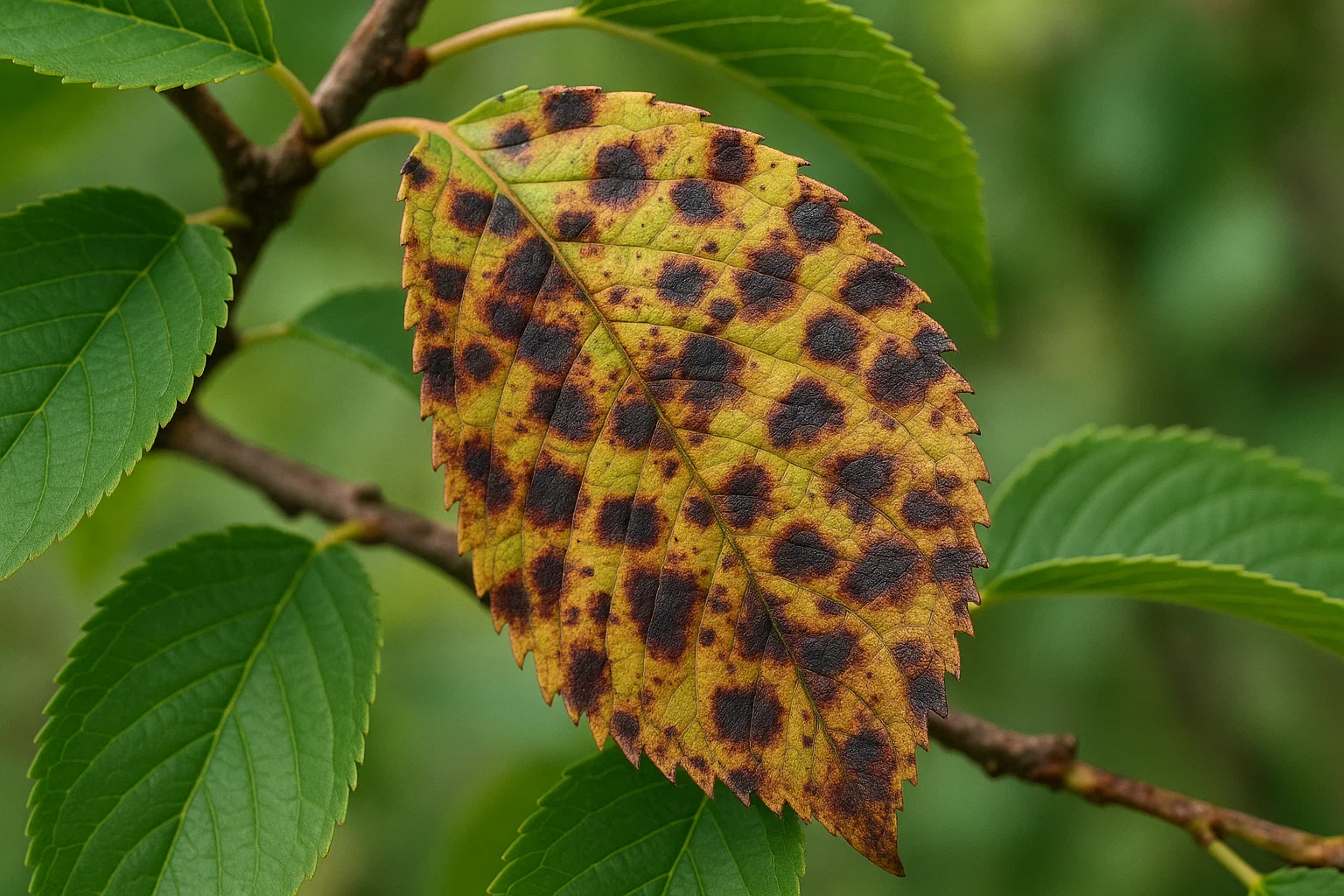
Cherry Leaf Spot 🍂
This fungal disease causes dark spots on leaves, leading to early leaf drop. It weakens the tree and affects fruit development.
Brown Rot 🍑
Affects both flowers and fruit, causing them to rot, especially during wet conditions. It can spread quickly if not controlled.
Powdery Mildew 🌬️
A white, powdery substance on leaves, stems, and buds. It stunts growth and reduces photosynthesis.
Bacterial Canker 💔
A serious condition causing cankers or lesions on the tree’s bark, which can eventually kill branches.
Root Rot 🏝️
Poor drainage and overwatering can lead to root rot, which damages the tree’s root system, causing wilting and poor growth.
Recognizing these symptoms early on is key! Keep an eye out for unusual leaf spots, wilting, or any changes in the tree’s appearance. Early detection leads to quicker, more effective treatments. 🌿💪
Proper Planting Techniques 🌳🌞
Planting your cherry tree in the right spot is crucial for its health and disease prevention. Follow these simple tips to set your tree up for success:
Choose the Right Location 📍
Cherry trees need full sunlight to thrive. Select a spot that gets at least 6 hours of sunlight daily. Avoid areas with heavy shade or poor air circulation, as these conditions promote fungal growth.

Soil Quality 🏞️
Cherry trees prefer well-draining soil with a slightly acidic to neutral pH (around 6.0–7.0). Before planting, test your soil and amend it with compost or organic matter if needed. This helps improve drainage and soil structure, reducing the risk of root rot.
Space It Right 🧑🌾
Give your tree plenty of space to grow. Cherry trees need room for air to circulate, which helps prevent diseases like powdery mildew. Plant your tree at least 20–30 feet away from other trees or structures to avoid crowding.
By setting up your cherry tree in the perfect location with healthy soil and enough space, you give it the best chance to grow strong and disease-free. 🌳💚
Regular Pruning and Maintenance ✂️🌿
Pruning is an essential part of cherry tree care that not only shapes the tree but also helps prevent diseases. Here’s how to keep your tree healthy with proper pruning and maintenance:
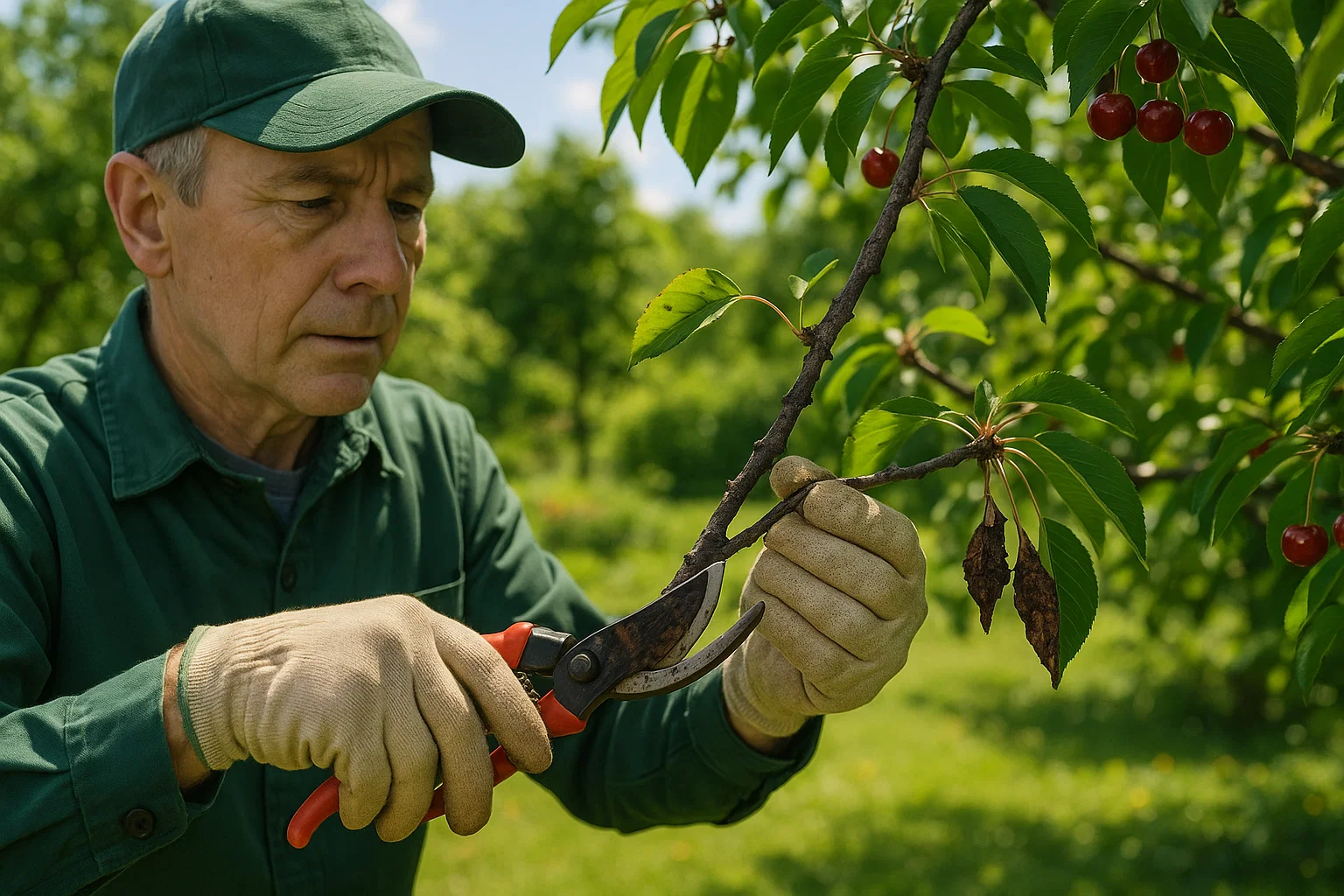
- When to Prune 🗓️: The best time to prune is during the late winter or early spring before new growth starts. This reduces the risk of spreading diseases and encourages healthy growth. Avoid pruning in wet conditions, as moisture can promote fungal infections.
- How to Prune ✂️: Remove any dead, diseased, or damaged branches to prevent infection from spreading. Always make clean cuts with sharp pruning tools, ensuring the cuts are smooth to minimize the risk of infection.
- Open Up the Canopy 🌬️: Prune to allow more air and sunlight to reach the center of the tree. This improves airflow, which reduces the likelihood of fungal diseases like powdery mildew.
- Avoid Over-Pruning 🚫: While pruning is important, over-pruning can weaken the tree. Remove no more than 20% of the tree’s branches at a time.
Regular pruning not only keeps your cherry tree looking tidy but also strengthens it by reducing the risk of disease. Keep your tools clean and sharpened for the best results! 🌳✨
Watering and Fertilization Practices 💧🌱
Proper watering and fertilizing play a big role in keeping your cherry tree healthy and disease-resistant. Here’s how to do it right:
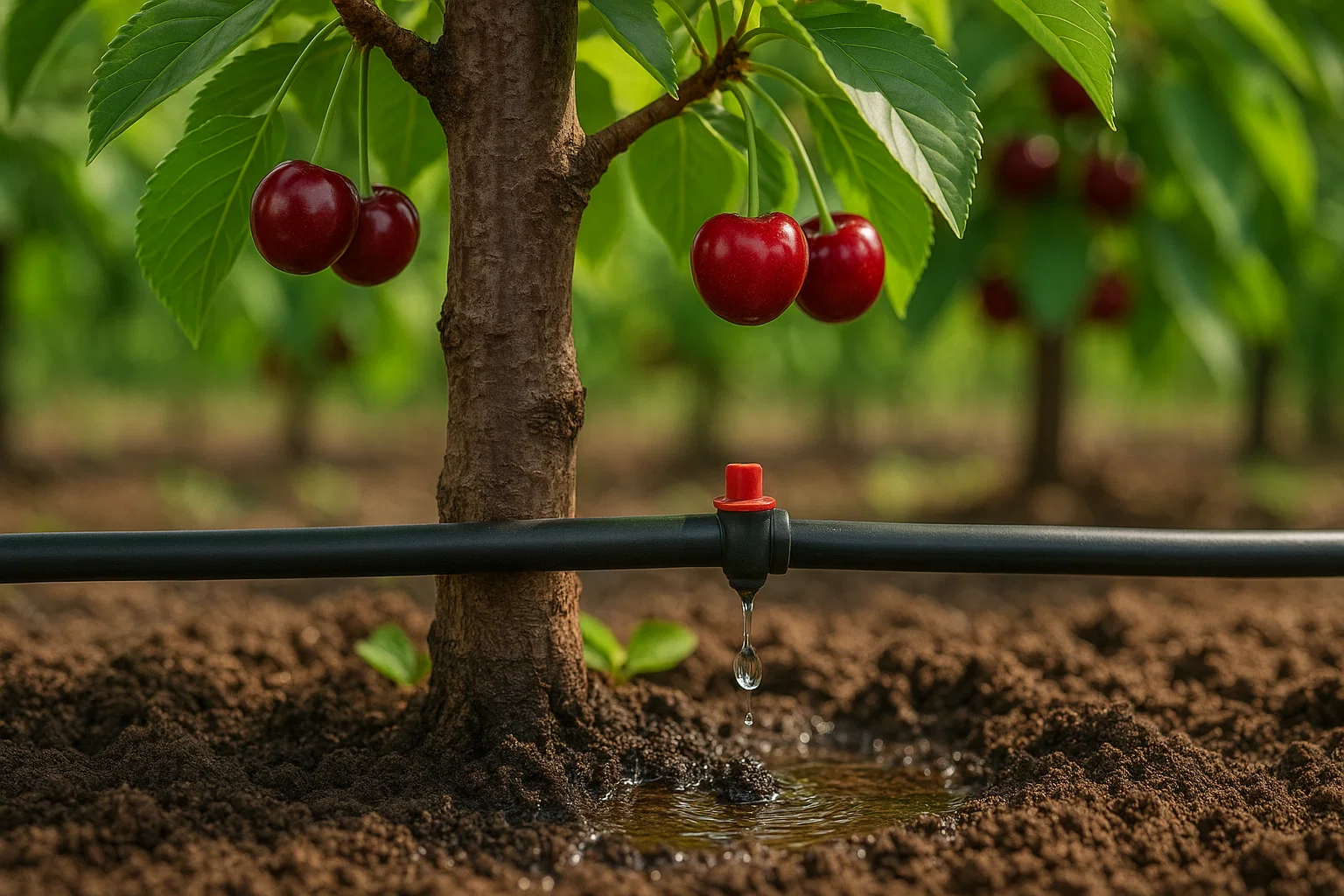
Watering Techniques 💦
Cherry trees prefer deep, infrequent watering rather than frequent shallow watering. Water deeply once a week, especially during dry spells, to encourage strong root growth. Avoid watering the leaves and fruit, as wet conditions can lead to fungal diseases like brown rot. A drip irrigation system is a great option to keep the base of the tree moist without wetting the foliage.
Well-Drained Soil 🌾
Ensure your soil drains well to prevent water from accumulating around the roots, which can cause root rot. If your soil is heavy or clay-like, amend it with compost to improve drainage.
Fertilizing Tips 🌸
Use a balanced, slow-release fertilizer that’s specifically designed for fruit trees. Apply fertilizer in early spring before the tree starts to bloom, and again in late summer to promote healthy growth. Avoid over-fertilizing, as it can make the tree more susceptible to disease.
By following these watering and fertilizing tips, you can help your cherry tree stay strong, vibrant, and less prone to diseases. 🌳💚
Disease-Resistant Varieties 🌳🍒
Choosing the right cherry tree variety can make all the difference when it comes to disease prevention. Some cherry trees are naturally more resistant to common diseases, helping reduce the amount of care and treatment they require. Here’s what you need to know:
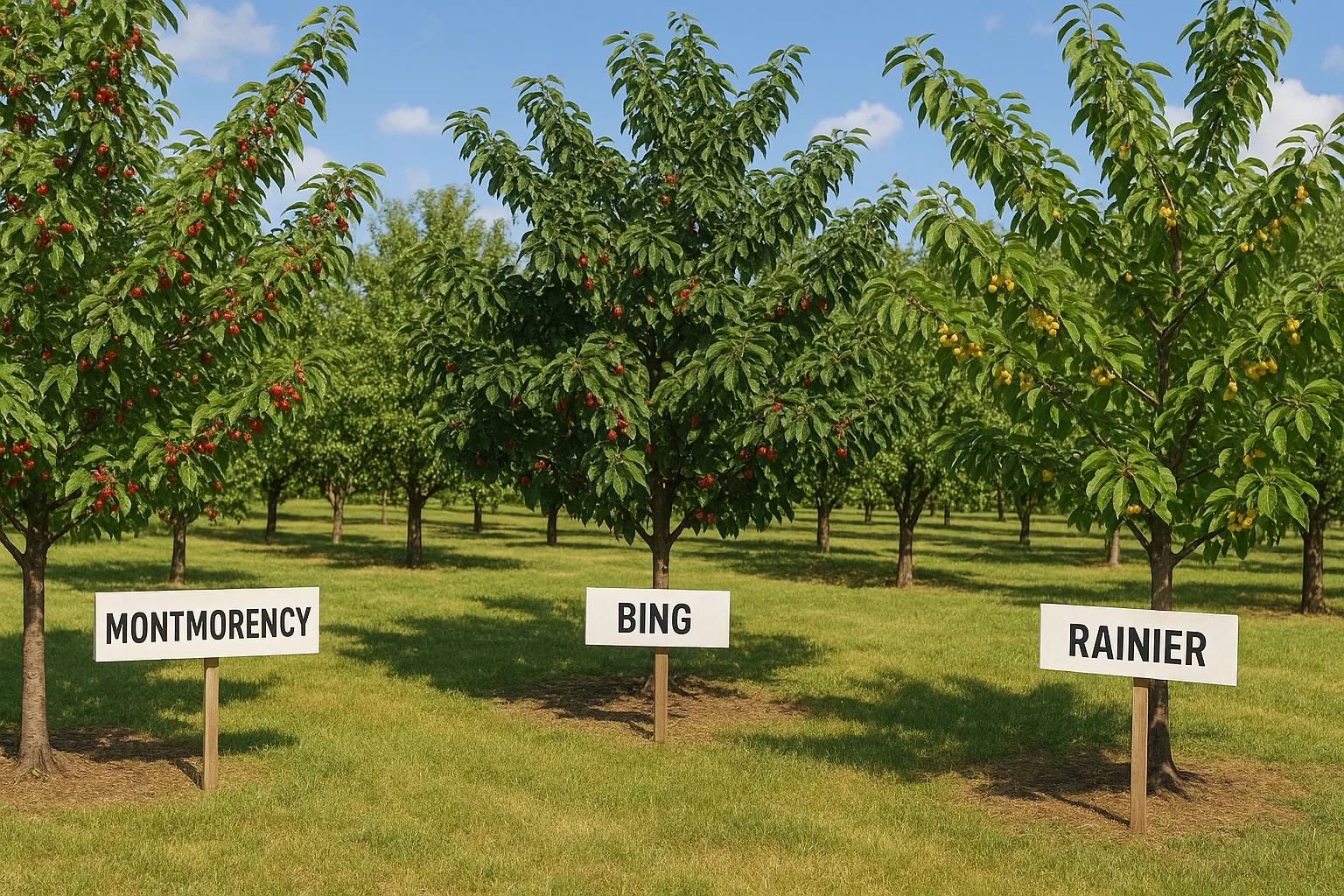
Why Disease-Resistant Varieties Matter 🛡️
Disease-resistant varieties are bred to withstand certain pathogens and pests, reducing the risk of common diseases like cherry leaf spot, brown rot, and powdery mildew. By selecting a resistant variety, you’ll spend less time battling disease and more time enjoying the beauty of your tree.
Top Disease-Resistant Varieties 🌟
- Montmorency: A tart cherry variety that’s known for its resistance to several common diseases and pests.
- Bing: A popular sweet cherry variety, Bing cherries are relatively resistant to diseases like brown rot and bacterial canker.
- Rainier: A hybrid sweet cherry that is more resistant to fungal diseases compared to other sweet cherry varieties.
Local Recommendations 🏡
Always check with your local garden center or extension service for the best disease-resistant cherry varieties suited to your climate and growing conditions.
By planting a disease-resistant variety, you’re giving your cherry tree a head start in the battle against common plant diseases. 🌳💪 To make informed choices and strengthen your tree’s defenses, refer to How to Prevent Cherry Tree Diseases: Essential Care Tips for expert recommendations.
Pest Management 🐞🌿
Pests can not only damage your cherry tree but also spread diseases, making effective pest management crucial for tree health. Here’s how to keep pests at bay:
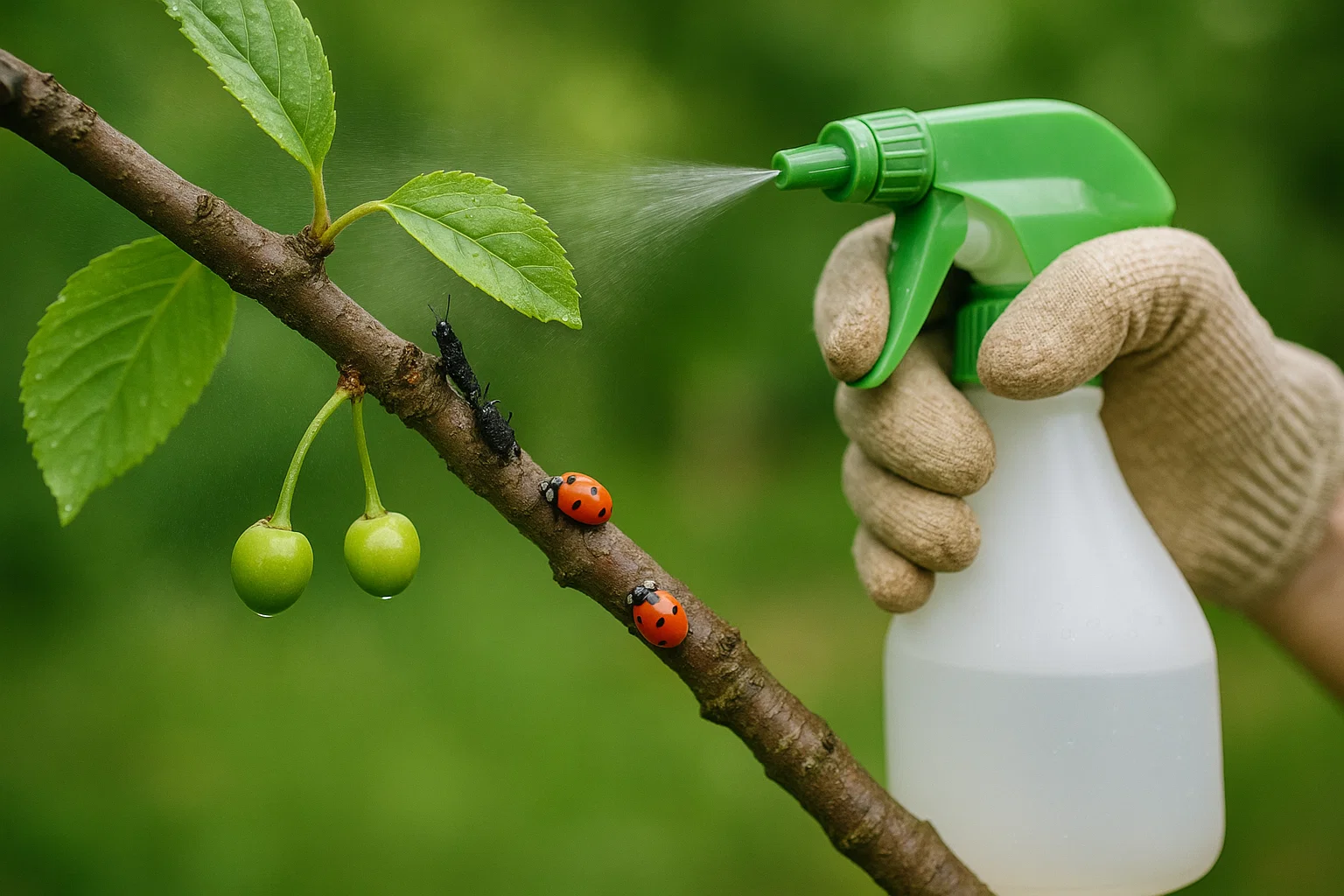
Common Cherry Tree Pests 🦗
- Aphids: These small insects suck sap from leaves, weakening the tree and potentially spreading diseases.
- Spider Mites: Tiny pests that cause yellowing and speckled leaves.
- Cherry Fruit Fly: A pest that infects the fruit, leading to premature fruit drop and rotting.
Integrated Pest Management (IPM) 🌍
- Natural Predators 🦋: Encourage beneficial insects like ladybugs and lacewings, which feed on aphids and other pests.
- Traps 🪤: Use sticky traps or pheromone traps to catch and monitor pest populations.
- Organic Sprays 🍃: Apply organic insecticides like neem oil or insecticidal soap to treat mild infestations without harming the environment.
- Regular Monitoring 🔍: Keep an eye on your cherry tree, especially during the growing season. Look for signs of pests, such as distorted leaves, webbing, or visible insects. Early detection allows for quicker, more effective treatment.
By managing pests through natural methods and regular monitoring, you can keep your cherry tree healthy and free from harmful pests that could cause disease. 🌳✨ For a comprehensive approach to disease prevention, check out How to Prevent Cherry Tree Diseases: Essential Care Tips and protect your tree year-round.
Seasonal Care and Monitoring 🌸❄️
Taking care of your cherry tree throughout the seasons ensures its health and prevents diseases from taking hold. Here’s how to manage seasonal care and monitor your tree effectively:

Spring and Summer Care 🌞
- Early Season Check: As your cherry tree starts to bloom, inspect it for early signs of disease or pest activity. Look for yellowing leaves, spots, or any wilting branches.
- Regular Watering: During the warmer months, ensure your tree gets deep, consistent watering. Avoid overhead watering to prevent fungal diseases.
- Pruning: Trim away any dead or damaged branches to improve airflow and reduce the risk of fungal infections.
Fall and Winter Care ❄️
- Fallen Leaves: Remove fallen leaves, especially those showing signs of disease, to reduce the risk of fungal spores overwintering in your garden.
- Protection from Cold: If your area experiences harsh winters, consider covering your tree with burlap or mulch around the base to protect the roots from freezing.
- Inspect the Tree: Check the trunk and branches for any cracks or signs of damage that could lead to bacterial canker or other infections.
Regular Monitoring 🔍
Throughout the year, inspect your cherry tree for pests and disease symptoms. Catching issues early allows you to take action before they spread.
By staying on top of seasonal care, your cherry tree will be better equipped to fight off diseases and thrive year-round. 🌳💚 For more ways to protect your tree, explore How to Prevent Cherry Tree Diseases: Essential Care Tips for practical, easy-to-follow guidance.
Treating and Managing Diseases 🛠️🌿
When it comes to cherry tree diseases, early detection and treatment are essential. Here’s how to effectively manage and treat any issues that arise:
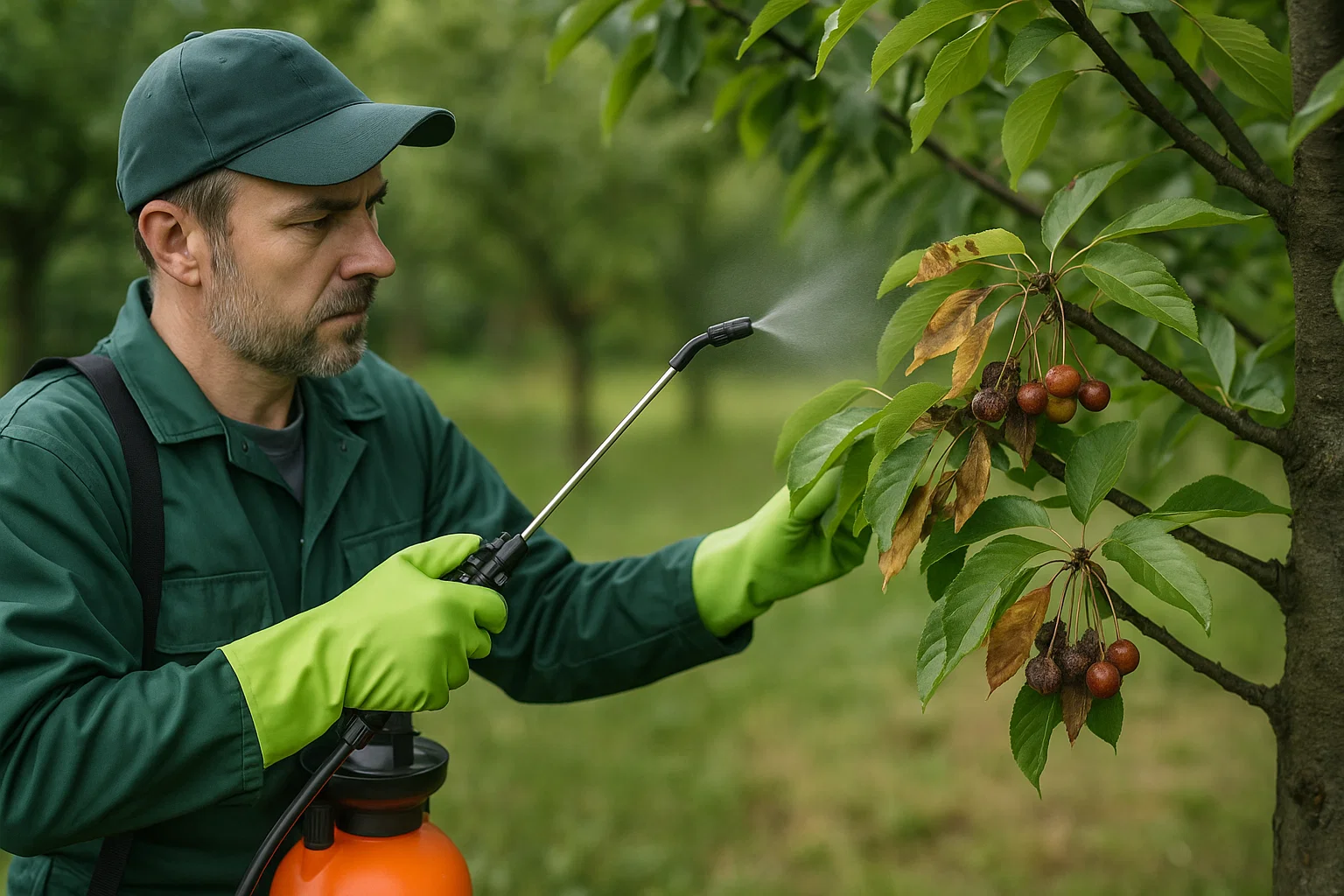
Early Detection is Key 👀
Regularly inspect your tree for signs of disease such as wilting, leaf spots, or unusual growth patterns. The sooner you spot a problem, the easier it is to treat.
Organic and Chemical Treatments 🌱⚗️
- Fungicides: If you notice fungal diseases like powdery mildew or cherry leaf spot, applying a fungicide early in the season can help control the spread. Opt for organic options like neem oil or sulfur, or use chemical treatments if necessary.
- Bactericides: For bacterial canker, applying copper-based bactericides during the dormant season can reduce the risk of infection.
- Spot Treatments: For smaller issues, you can treat individual affected areas with targeted sprays instead of treating the entire tree.
Prune Affected Areas ✂️
Remove and dispose of any infected branches or leaves to prevent the disease from spreading. Always clean your tools between cuts to avoid contamination.
Seek Professional Help 👨🌾
If a disease persists or worsens despite treatment, it may be time to consult an arborist. A professional can identify the problem and recommend more advanced treatments or management strategies.
By staying proactive and using the right treatments, you can help your cherry tree recover from diseases and prevent future issues. 🌳💪
Preventing Disease Spread 🚫🌿
Once you spot a disease in your cherry tree, it’s crucial to act quickly to prevent it from spreading to other trees. Here’s how to stop the spread and protect your garden:
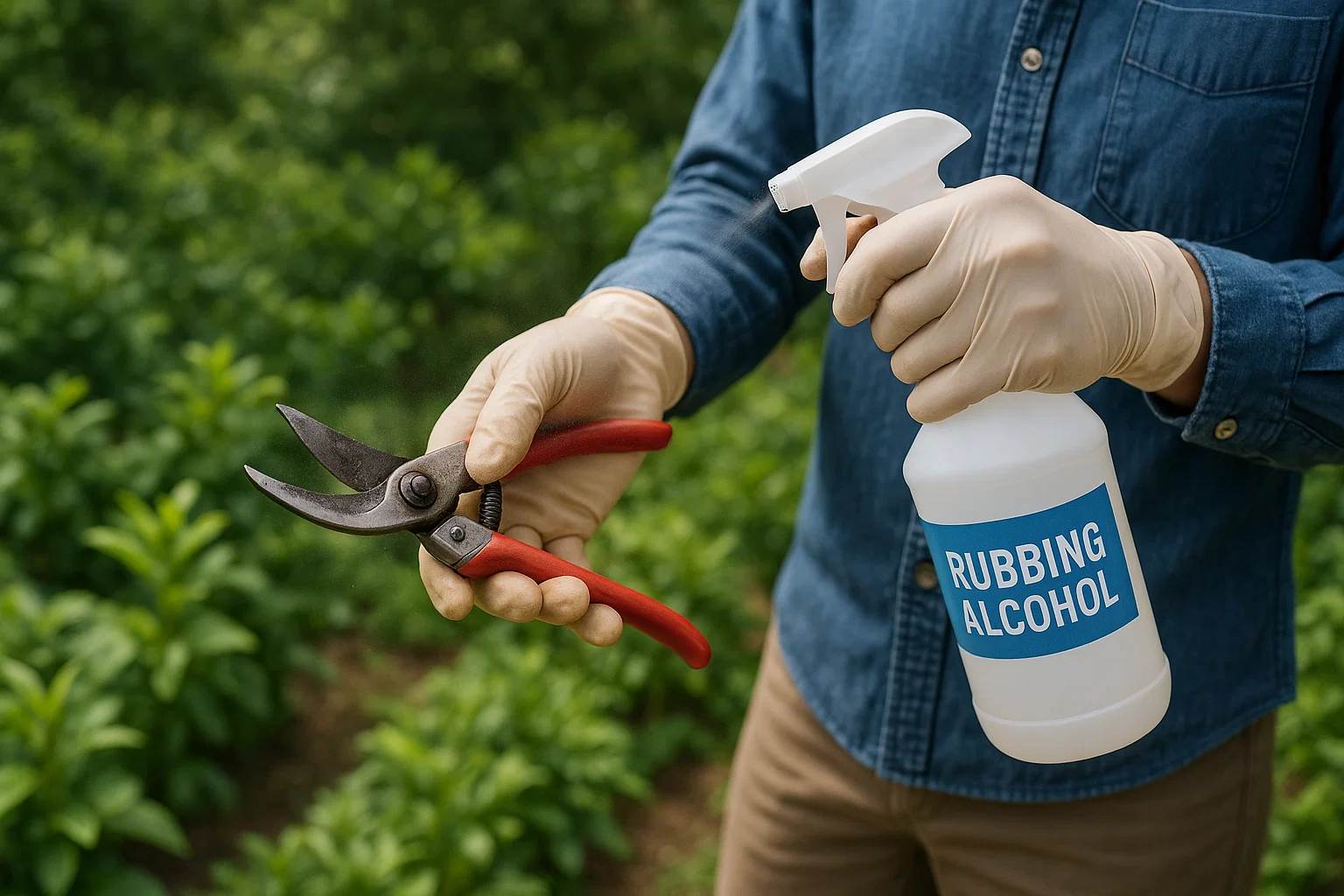
Disinfect Tools 🧴
Always clean your pruning shears, saws, and any other tools you use on the tree. After trimming or cutting diseased branches, disinfect your tools with rubbing alcohol or a bleach solution (1 part bleach to 9 parts water) to avoid transferring pathogens.
Proper Disposal 🗑️
Never compost infected leaves or branches. Instead, dispose of them in a sealed bag or burn them to prevent the disease from re-emerging. This keeps harmful spores from spreading through the environment.
Isolate New Plants 🌱
When introducing new cherry trees or plants to your garden, quarantine them for at least a few weeks. This ensures they aren’t bringing in any diseases that could infect your existing plants.
Avoid Wetting the Foliage 🌧️
When watering, avoid spraying water on the leaves and fruit, as moisture can spread fungal diseases. Use drip irrigation or water at the base of the tree to keep the foliage dry.
Monitor Surrounding Plants 👀
Check other trees or plants in your garden regularly for any signs of disease. Pests and pathogens can travel quickly, so staying vigilant in other areas of your garden is essential for disease control.
By following these preventative measures, you can minimize the risk of disease spreading, keeping your cherry tree and other plants safe. 🌳✨
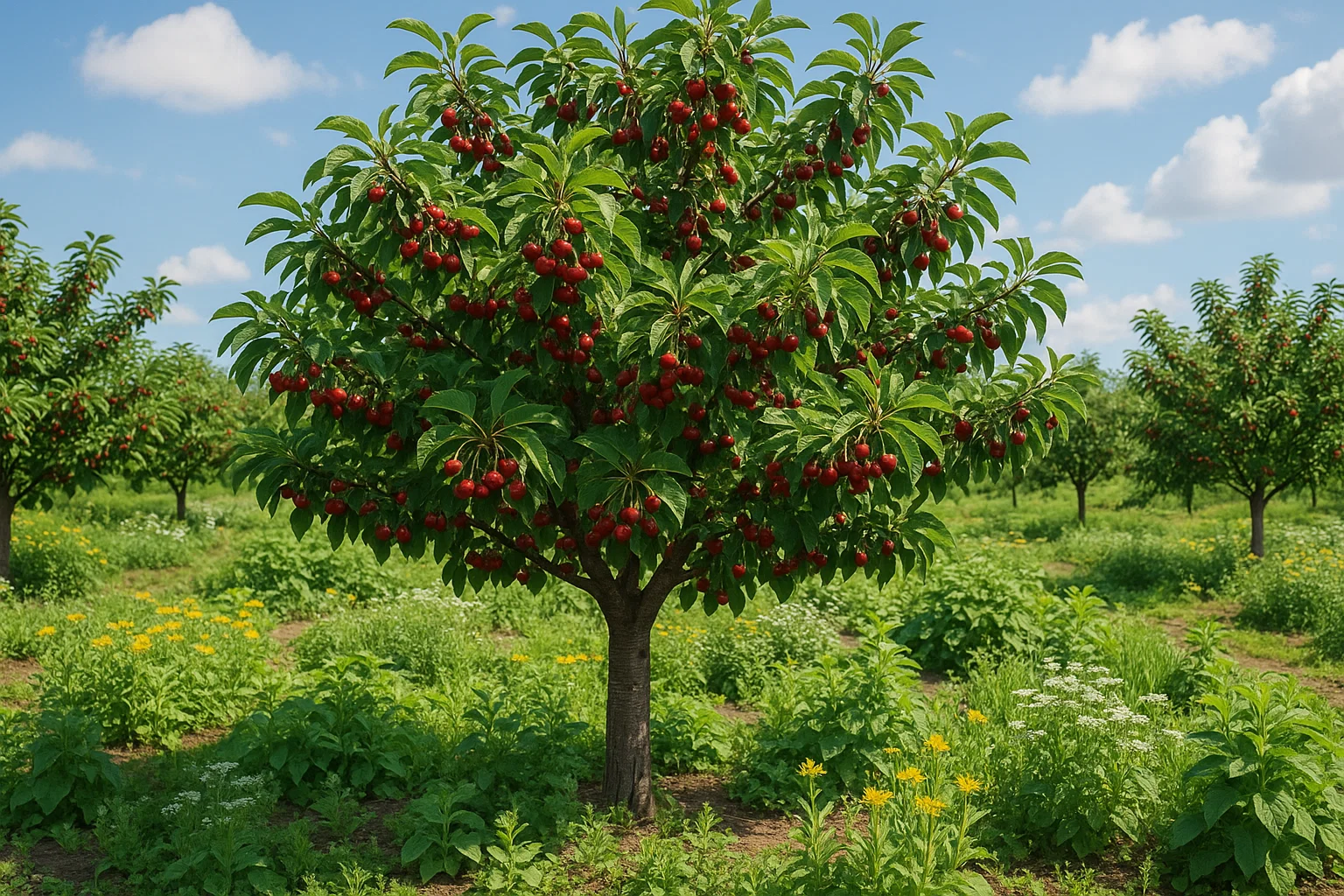
Final Thoughts 🌟🌳
Caring for your cherry tree requires attention, patience, and the right knowledge to prevent diseases and ensure long-lasting health. By following these essential care tips, you’ll not only protect your tree from common diseases but also enjoy its beauty and fruit for years to come. Remember, the key to a thriving cherry tree is a combination of proper planting, regular monitoring, and timely treatment. So, take the time to nurture your tree, and it will reward you with delicious, vibrant cherries! 🍒💚 Keep an eye on your tree, stay proactive, and watch it flourish season after season. 🌿
Frequently Asked Questions (FAQ)
What are the most common diseases that affect cherry trees?
Common diseases include cherry leaf spot, brown rot, powdery mildew, bacterial canker, and root rot. Regular inspection can help identify and treat them early.
How can I prevent cherry leaf spot on my tree?
To prevent cherry leaf spot, ensure proper spacing for airflow, avoid overhead watering, and use fungicides when necessary, especially during rainy periods.
What is the best time to prune cherry trees to avoid diseases?
Prune your cherry tree during late winter or early spring before new growth begins. This reduces the risk of spreading disease and encourages healthy growth.
Are there any cherry tree varieties resistant to diseases?
Yes! Disease-resistant varieties like Montmorency, Bing, and Rainier are less prone to common issues like brown rot and bacterial canker.
How often should I water my cherry tree?
Water your cherry tree deeply once a week, especially during dry periods. Avoid overhead watering to prevent fungal diseases and ensure the soil drains well.
Can pests spread diseases to my cherry tree?
Yes, pests like aphids and spider mites can spread diseases by damaging the tree and acting as carriers. Regular pest management can help prevent this.
How do I know if my cherry tree has a disease?
Look for signs like yellowing leaves, wilting, spots, or unusual growth. Early detection is key to managing and treating diseases effectively.
What should I do if my cherry tree gets infected with a disease?
Prune affected branches, apply appropriate treatments like fungicides or bactericides, and remove infected plant material to prevent further spread.
